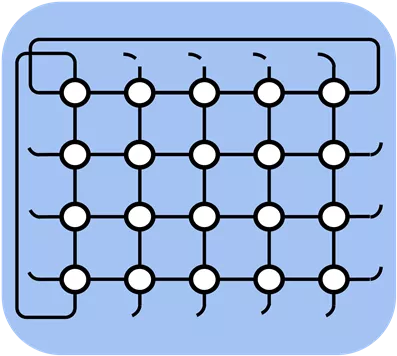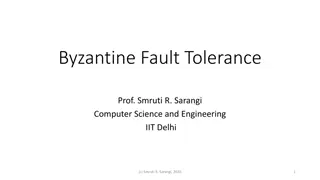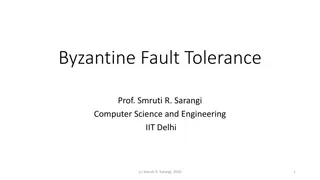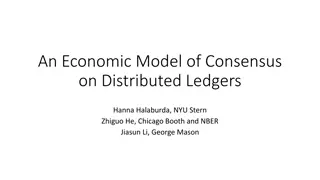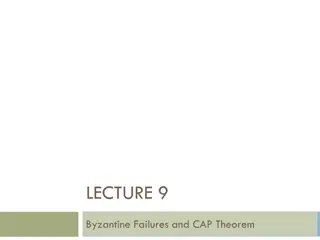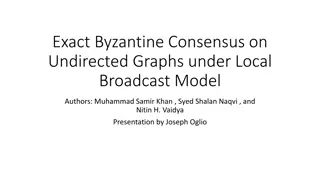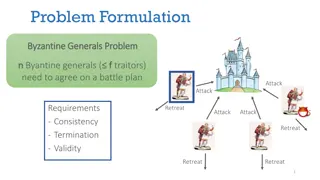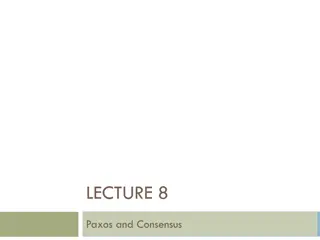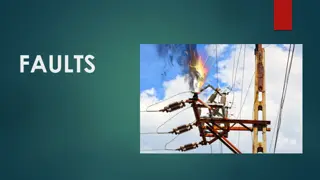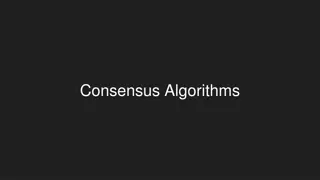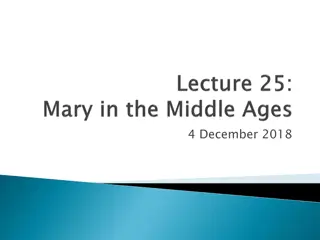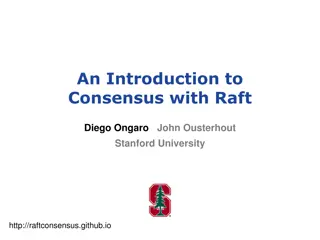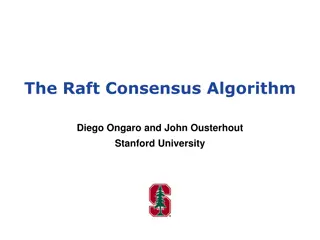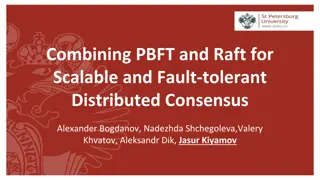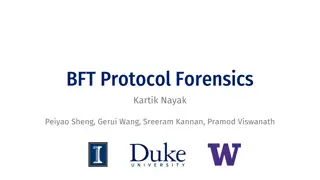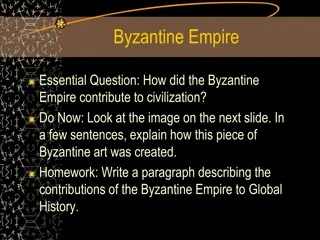Byzantine Faults and Consensus on Unknown Torus
The discussion revolves around achieving consensus in the presence of dense Byzantine faults on an unknown torus. Various challenges and impossibility theorems are explored, highlighting the complexities of reaching an agreement in such fault-prone environments. The content delves into the limitations imposed by fault locations, faulty columns, and the need for specific network connectivity to achieve consensus. Additionally, it introduces concepts like Dense Byzantine Faults and outlines the BAT algorithm for All-to-All Broadcast on a Torus Model.
Download Presentation

Please find below an Image/Link to download the presentation.
The content on the website is provided AS IS for your information and personal use only. It may not be sold, licensed, or shared on other websites without obtaining consent from the author.If you encounter any issues during the download, it is possible that the publisher has removed the file from their server.
You are allowed to download the files provided on this website for personal or commercial use, subject to the condition that they are used lawfully. All files are the property of their respective owners.
The content on the website is provided AS IS for your information and personal use only. It may not be sold, licensed, or shared on other websites without obtaining consent from the author.
E N D
Presentation Transcript
Consensus on an Unknown Torus with Dense Byzantine Faults Joseph Oglio Kendric Hood Gokarna Sharma Mikhail Nesterenko Marrakech, Morocco May 23, 2023
Dense Byzantine Faults & Consensus Byzantine fault - process behaves arbitrarily, f- number of faulty processes (classic) binary byzantine tolerant consensus [Lamport82] - all processes need to agree on a value interested in deterministic solutions without signatures (oral record) consider torus with dimensions unknown to processes fixed degree and small diameter: convenient for computing and storage tasks known dimensions: solution is simple incomplete topology [Dolev82] - need at least 2f+1 network connectivity: may tolerate at most 1 fault what to do? sparse faults - faulty processes are far enough apart to ensure Dolev s bound [Maurer14] want to solve for dense faults - faulty processes are arbitrarily close HOW? 2
Outline Impossibility BAT - all-to-all broadcast algorithm CBAT - consensus using BAT extension to CONGEST model 3
No Consensus with Arbitrary Fault Location there is no algorithm that solves consensus with f > 1 faults on a torus with connectivity 4 [Dolev82]. Intuition: consider 2 faults (black processes), the correct (grey processes) cannot tell which neighbors are Byzantine we restrict fault location to single column 4
No Consensus with a Faulty Column Theorem 1. There is no algorithm that solves consensus on a torus with a faulty column. Intuition: lets first consider a ring (a torus of height 1) with a single faulty process. Connectivity is 2, need 2f+1 = 3 to solve consensus [Dolev82] this argument can be extended to a torus of arbitrary height need at least one correct process in the faulty column notation black - faulty process grey - correct in faulty column white - correct in non-faulty column 5
Outline Impossibility BAT - all-to-all broadcast algorithm CBAT - consensus using BAT extension to CONGEST model 6
BAT: Byzantine All-to-All Broadcast on a Torus Model: synchronous, processes share orientation, every process has unique ids, knows immediate neighbors, torus size W H unknown to processes, arbitrary amount of data transmitted per round (LOCAL model) later relaxed to fixed size (CONGEST) Algorithm consists of four phases: North - collects info vertically East-West - collects info horizontally South - shares info vertically Decision - terminates 7
BAT: North Phase, White Columns white columns: a round 1: each process sends a message up containing its value Round: 2 3 4 Receive: c d a 5 b b round k>1, k < H+1: stores message and forwards it up c round H + 1: each process will receive its own initial value, store it, and move on to the East-West Phase remember: H, W and color are unknown to processes d 8
BAT: North Phase, Black-Grey Column u black processes may send arbitrary messages to the grey process grey process may complete its North Phase earlier than white, later or never v w x 9
BAT: East-West Phase process sends its entire column + left & right neighbor East(left) and West (right), saves in rowLeft and rowRight forwards received consider the case of the grey process starting the East-West Phase on time: together with white process b c d e a case (i) grey process on time, d s perspective rowLeft.d : rowRight.d: d d e a b c e a b c 10
BAT: East-West Phase process sends its entire column + left & right neighbor East(left) and West (right), saves in rowLeft and rowRight forwards received now consider the case of the grey process starting the East-West Phase out-of-sync: early columns not shown b c d e a case (ii) grey process early, d s perspective rowLeft.d : rowRight.d: d d e a c/b e a/b c 11
BAT: East-West Phase Right/Left Match each white process determines completion of the phase despite single grey/black process possibly out- of-sync two steps checks rowLeft, rowRight individually: no duplicate ids, neighbors matching, at most one process off replace off process column info with compare rowLeft with rowRight: if they match, phase is complete b c d e a case (i) grey process on time, d s perspective case (ii) grey process early, d s perspective rowLeft.d : rowRight.d: rowLeft.d : rowRight.d: d d e a b c d d e a c e a b c e a c 12
BAT: East-West Phase, Completion if rowLeft matches rowRight at process d: have decision matrix: correct values of all white processes, guaranteed to happen to every white process in grey-white row may happen in black-white row then d outputs the matrix, starts South Phase and Decision Phase b c d e a case (i) grey process on time, d s perspective case (ii) grey process early, d s perspective rowLeft.d : rowRight.d: rowLeft.d : rowRight.d: d d e a b c d d e a c e a b c e a c 13
BAT: South & Decision Phase South Phase: share decision matrix. A white process that completed East-West Phase has decision matrix sends it to other white processes in same column when received, forward down, output, start Decision Phase Decision Phase: guarantees white termination despite a black neighbor after South Phase, a white process informs immediate left and right neighbor terminates if decision matrix and heard from either left or right every white process terminates grey process does not terminate prematurely: even if gets faulty info from black up/down neighbors, does not hear from white left/right neighbors 14
BAT: All-to-All Broadcast Theorem 2. Algorithm BAT solves the Weak Synchronous All-to-All Broadcast Problem on an unknown torus with Byzantine faults in at most one column with at least one correct row in at most 2H+2+W rounds. Intuition: North Phase takes H + 1 rounds to share each processes initial value with its column East-West Phase : W rounds to propagate South Phase: H rounds to share the decision matrix Decision Phase: 1 round to terminate BAT 15
Outline Impossibility BAT - all-to-all broadcast algorithm CBAT - consensus using BAT extension to CONGEST model 16
All-to-All Broadcast Consensus simple all-to-all broadcast is insufficient: the values of black processes may differ in the decision matrix of different white processes black processes may send different values to different white processes and influence their decision CBAT: use BAT twice to verify received decision matrices 17
CBAT: Consensus Using BAT Stages Broadcast Confirm Decide use BAT to form initial decision matrices use BAT exchange initial decision matrices select the highest id process to be leader check if leaders decision matrix (constructed from the values heard from the other peers) is consistent (requires W > 4) two or more columns contain: (BAT detected the leader to be faulty) both 0s and 1s or whose values differ from the rest if not consistent: all white processes detect it, all select same leader from a different column: guaranteed to be white output the majority of the values shared by this leader 18
Consensus on a Torus Theorem 3. CBAT solves weak consensus on an unknown torus whose width is at least 5 with Byzantine faults in at most one column and with at least one correct row. Intuition: use BAT to share everyone s value use BAT again, this time sharing what everyone heard compute a shared set of values by finding the byzantine leader if they misbehaved output the majority decision among the non byzantine columns 19
Outline Impossibility BAT - all-to-all broadcast algorithm CBAT - consensus using BAT extension to CONGEST model 20
Extension to Fixed Message Size: BAT LOCAL: process may send arbitrary amount of data per round CONGEST: process may only send (1) per round BAT LOCAL Phases: North: message size is 1 (H rounds) East-West: message size of H (W rounds) South: message size of H W (H rounds) Decide: O(1) in the North Phase, processes determine H, can transmit column in H fixed-size rounds, in East-West Phase determine W, can transmit matrix in H W rounds, hence: BAT CONGEST Phases: North: O(H) East-West: O(H W) South: O(H2 W) 21
Extension to Fixed Message Size: CBAT similarly: CBAT LOCAL: Broadcast: BAT(initVal) - message size of O(H W) Confirm: BAT(H*W matrix) - O(H2 W2) Decide: local computation CBAT CONGEST: Broadcast: BAT(initVal) - O(H2 W) Confirm: BAT(H W matrix) - O(H3 W2) 22
Byzantine Torus Recap We posed the Byzantine Torus Problems proved it impossible if there is a complete faulty column presented BAT: all-to-all broadcast on a torus presented CBAT: uses BAT to solve consensus extended results to fixed message size Questions? 23





